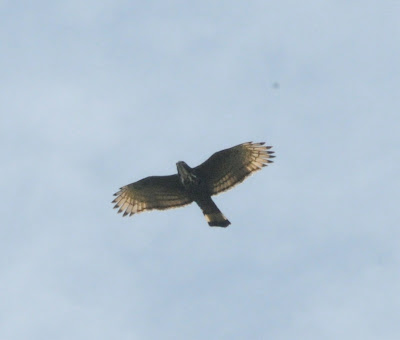My Ba Kelalan Birds List (Limited just around the school compound).
1. Yellow Bittern - feeding in fish pond
2. Little Egret - very common in paddyfield
3. Intermediate Egret - common in paddy field
4. Great Egret
5. Cattle Egret
6. Blyth's Hawk-eagle - In flight
7. Changeable Hawk-eagle - Perched on bamboo
8. Osprey - In flight
9. Brahminy Kite - In flight
10. Black Eagle - Pair in flight
11. Crested Serpent Eagle - Perched on tree
12. Crested Goshawk - Building nest on "Terap" Tree
13. White-breasted Waterhen - very common bird in paddy field
14. Wood Sandpiper - near fish pond
15. Ruddy Cuckoo-dove - Feeding in groups of four.
16. Little Cuckoo-dove - Perched on a tree
17. Spotted Dove - common bird
18. Emerald Dove - Feeding on the ground
19. Thick-billed Green Pigeon - Pair perched on a tree
20. Pink-necked Green Pigeon - in group of four to twenty
21. Green Imperial Pigeon - Feeding during fruit season
22. Greater Coucal
23. Lesser Coucal
24. Chestnut-breasted Malkoha - Feeding in pair
25. Red-bearded Bee-eater
26. Dollarbird
27. Gold-whiskered Barbet - Feeding wild berries
28. Crimson-winged Woodpecker
29. Black-and-yellow Broadbill - perched on tree
30. Greater Green Leafbird - feeding in pair
31. Scarlet Minivet - feeding in pair
32. Bar-winged Flycatcher-shrike - perched on tree
33. Tiger Shrike - perched on tree
34. Asian Fairy Bluebird - 1 male and 4 female feeding
35. Ashy Drongo - very common bird
36. Hair-crested Drongo - Common bird and nesting nearby
37. Short-tailed Green Magpie - feeding in pair
38. Common Green Magpie - feeding in pair
39. Bornean Treepie - perched on high tree
40. White-breasted Woodswallow - common bird
41. Pacific Swallow - very common bird
42. Red-headed Tailorbird/Ashy Tailorbird - feeding
43. Black-headed Bulbul - feeding in group of 4 to 10
44. Yellow-vented Bulbul - most common bird
45. Cream-vented Bulbul - perched
46. Red-eyed Bulbul - perched and feeding
47. Cinereous Bulbul/Ashy Bulbul - perched on tree
48. Bornean Bulbul/Black-crested Bulbul - Feeding in pair
49. Artic Warbler - Feeding
50. Sunda Bush-warbler - Perched on tree
51. Bornean Wren-Babler - Feeding in the bushes
52. Chestnut-hooded Laughingthrush - Feeding in group of 4 to 6
53. Oriental Magpie Robin - common bird
54. White-rumped Shama - perched
55. Asian Brown Flycatcher - common bird
56. Blue-and-white Flycatcher - perched on tree
57. Pied Fantail - common bird
58. Plain Flowerpecker - Feeding
59. Orange-bellied Flowerpecker - very common
60. Yellow-rumped Flowerpecker - feeding
61. Yellow-vented Flowerpecker - feeding
62. Purple-throated Sunbird/Van Hasselt’s Sunbird - feeding in pair
63. Olive-backed Sunbird - feeding
64. Crimson Sunbird - feeding
65. Plain Sunbird - feeding
66. Brown-throated Sunbird - perched
67. Ruby-cheeked Sunbird - perched
68. Little Spiderhunter - feeding
69. Yellow-eared Spiderhunter - feeding
70. Long-billed Spiderhunter - feeding
71. Streaky-breasted Spiderhunter - feeding on banana flower
72. Chestnut Munia/Black-headed Munia - very common
73. Dusky Munia - very common
74. Grey Wagtail - perched near the river
75. Eurasian Tree Sparrow - very common
I also saw a pair of hornbill in flight but they're quite far away uphill.
I will update the list from time to time.































































